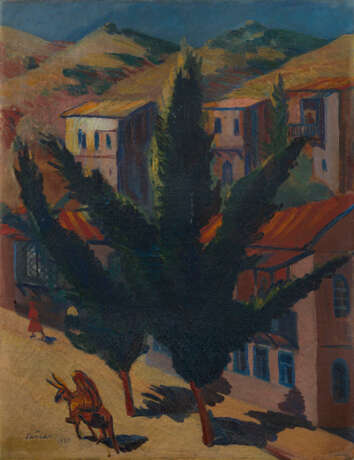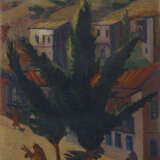SARYAN, MARTIROS (1880-1972) Rue d'une ville caucasienne, Tiflis , signed and dated 1927, also further signed twice and dated on the reverse.
06.06.2018 12:30UTC +01:00
Classic
Vendu
307200GBP £ 307 200
| Auctioneer | MacDougall Arts Ltd. |
|---|---|
| Lieu de l'événement | Royaume-Uni, London |
Archive
La vente aux enchères est terminée. Vous ne pouvez plus enchérir.

ID 70691
Lot 26* | SARYAN, MARTIROS (1880-1972) Rue d'une ville caucasienne, Tiflis , signed and dated 1927, also further signed twice and dated on the reverse.
Valeur estimée
£ 250 000 – 400 000
Provenance: Collection of the artist.
Acquired from Anna Bugadyan, who acted on behalf of the artist, by a previous owner in Paris c. 1928.
Collection of Tigran Kelekyan, Paris.
Private collection, New Zealand.
Important private collection, Europe.
Authenticity of the work has been confirmed by the expert R. Saryan.
Exhibited: Exposition Martiros Sarian, Galerie Charles-Auguste Girard, Paris, 7–20 January 1928, No. 3.
Literature: Exhibition catalogue, Exposition Martiros Sarian, Galerie Charles-Auguste Girard, Paris, 7–20 January 1928, No. 3, listed.
R. Drampyan, Martiros Saryan, Yerevan, 1960, listed.
M. Saryan, Iz moei zhizni, Moscow, Izobrazitelnoe iskusstvo, 1970, p. 326, illustrated as View of Tiflis.
A. Kamensky, Martiros Saryan. Zhivopis, akvareli, risunki, illyustratsii. Teatralno-dekoratsionnoe iskusstvo, Leningrad, Aurora Art Publishers, 1987, p. 303, pl. 260, illustrated and listed as “Destroyed in 1928”.
A. Kamensky, S. Khachatryan, L. Mirzoyan, Martiros Saryan. Paintings, Watercolours, Drawings, Book Illustrations, Theatrical Design, Leningrad, Aurora Art Publishers, 1988, p. 303, No. 260, illustrated and as listed "Destroyed in 1928".
Martiros Saryan’s painting Rue d'une ville caucasienne, Tiflis — the title under which it was listed in the catalogue for the artist’s 1928 solo exhibition in Paris — has a surprising story with an unexpected ending.
After great success at the Venice Biennale of 1924 and at several exhibitions in Moscow, including the first show of the Four Arts Society in 1925, Saryan had the opportunity to go work in Paris. Saryan’s Paris period (1926–1928) was extremely productive and greatly significant in terms of undertaking new creative challenges. The solo exhibition in 1928 in Galerie Charles-Auguste Girard, for which the artist was preparing for a year and a half, was to be a kind of summation of everything he had developed and achieved in Paris in a comparatively short time.
In Paris Saryan painted about 37 pictures and brought five with him from Armenia. Thirty-six canvases were hung in the exhibition. At the end of the show, the artist packed up his pictures and dispatched them by sea back to his homeland via thePaquet shipping line. The ship Frigi, with Saryan’s paintings in the hold, steered a course from Marseille to Batumi, stopping off at the port of Istanbul. It was here that the fateful event took place. Fire broke out in the hold and all the artist’s paintings were burnt. The ship itself was unharmed and continued to sail the waters of the Mediterranean until 1946.
How Rue d'une ville caucasienne, Tiflis, presented now at auction, escaped the tragic fate of Saryan’s other Paris works which were burnt in 1928 in the hold of the Frigi? It was painted in 1927 and was first hung in the 1928 Saryan exhibition in the Galerie Girard in Paris. In the exhibition catalogue it is listed as “N 3”, Rue d'une ville caucasienne, Tiflis. But after the exhibition it transpired that it was not among the works that Saryan sent home by sea — and thank goodness for that.
The fate of the painting hadn't been clear for a long time. In the catalogue compiled by the celebrated art historian and director of Armenia’s National Picture Gallery, Ruben Grigorievich Drampyan, which was published as early as 1960, it is clearly stated that the picture entitled Rue d’une ville caucasienne was in the Paris collection of Tigran Kelekyan. According to that same catalogue, incidentally, another painting from Saryan’s Paris period, Still Life on a Blue Background, also painted in 1927, had likewise ended up in the same private collection. Yet for some reason, both these facts have been ignored in many publications, including the catalogue contained in the book on Saryan, published by Aurora Art Publishers in 1987, which notes that both works were destroyed.
Until recently we could only judge Rue d’une ville caucasienne, Tiflis from a black-and-white photograph taken in Paris, and only many years after it was created there was a chance to view the actual canvas again. It is remarkable both in its technique and composition. As Saryan himself opined, it is one of his “stronger works”. The picture is of exceptional significance for museums and we wish that it could by some miracle find its way to the Saryan House Museum in Yerevan or, at least, that it might enrich the collection of some European museum.
Rouzan Saryan, Director of the Martiros Saryan House Museum
| Adresse de l'enchère |
MacDougall Arts Ltd. 63 New Cavendish St. W1G 7LP London Royaume-Uni | |
|---|---|---|
| Aperçu |
| |
| Téléphone | +44 20 7389 8160 | |
| Téléphone | +7 495 799 4683 | |
| Fax | +44 (0) 20 7389 8170 | |
| Conditions d'utilisation | Conditions d'utilisation | |
| transport |
Service postal Service de messagerie ramassage par vous-même | |
| Modes de paiement |
Virement bancaire |




